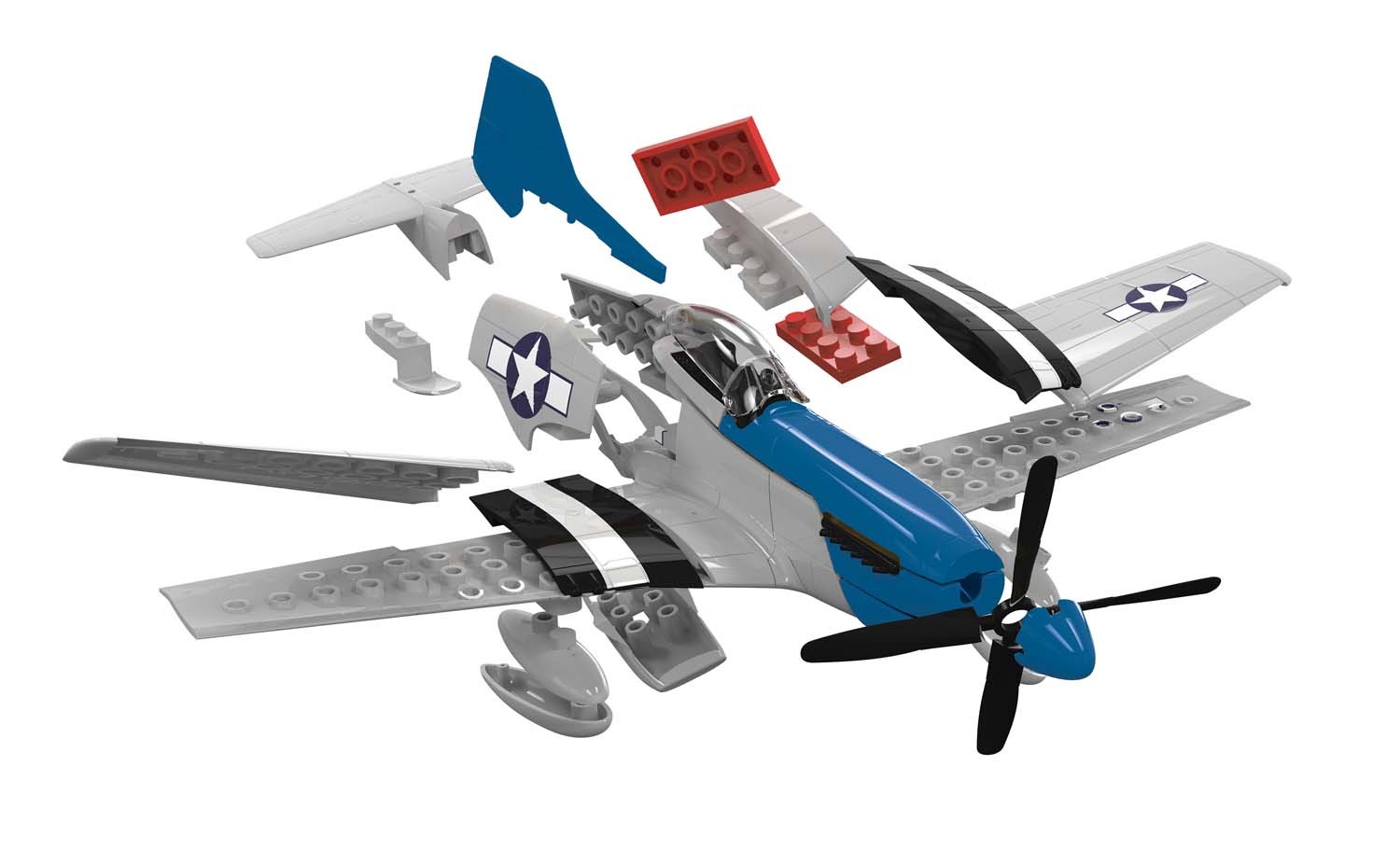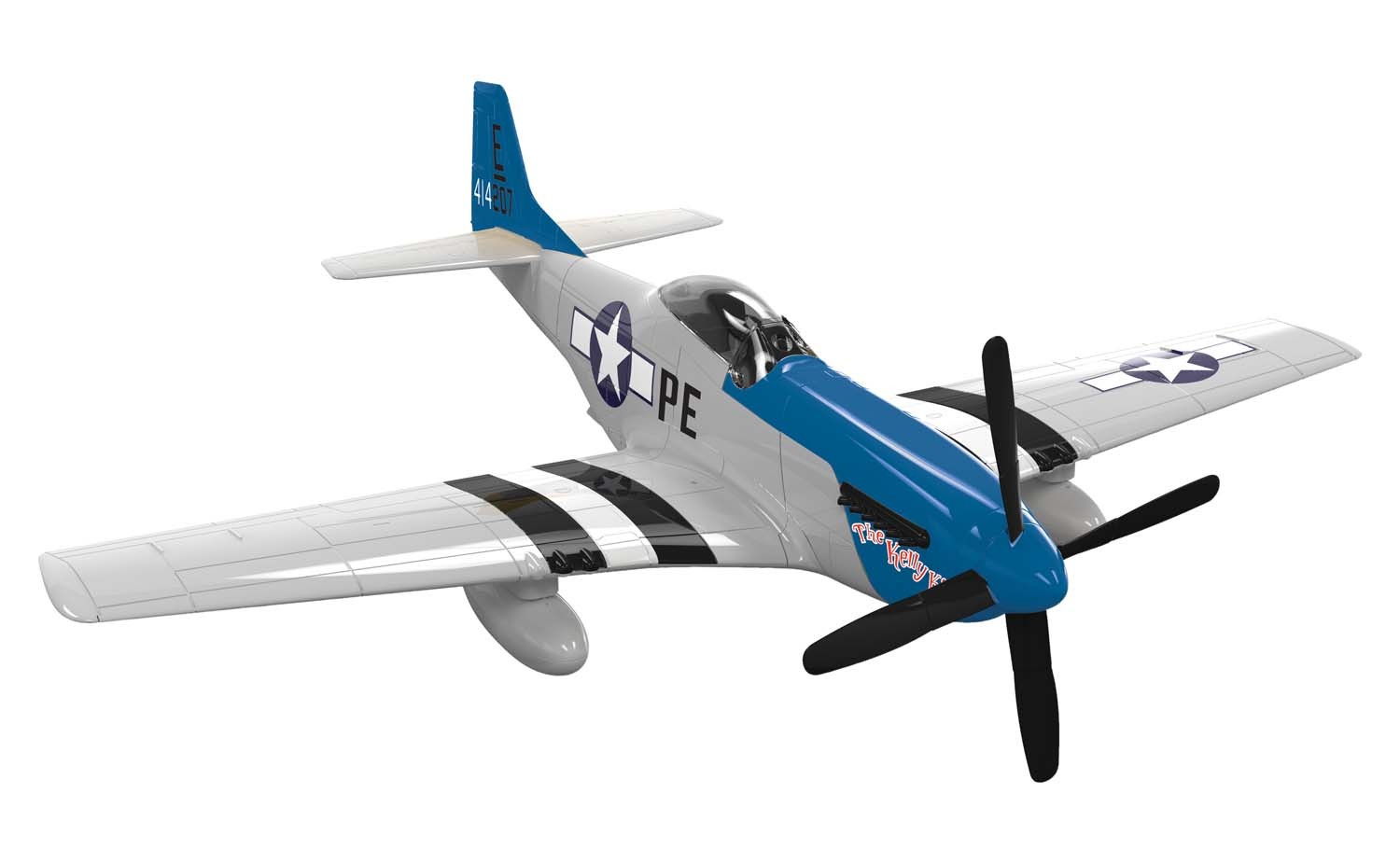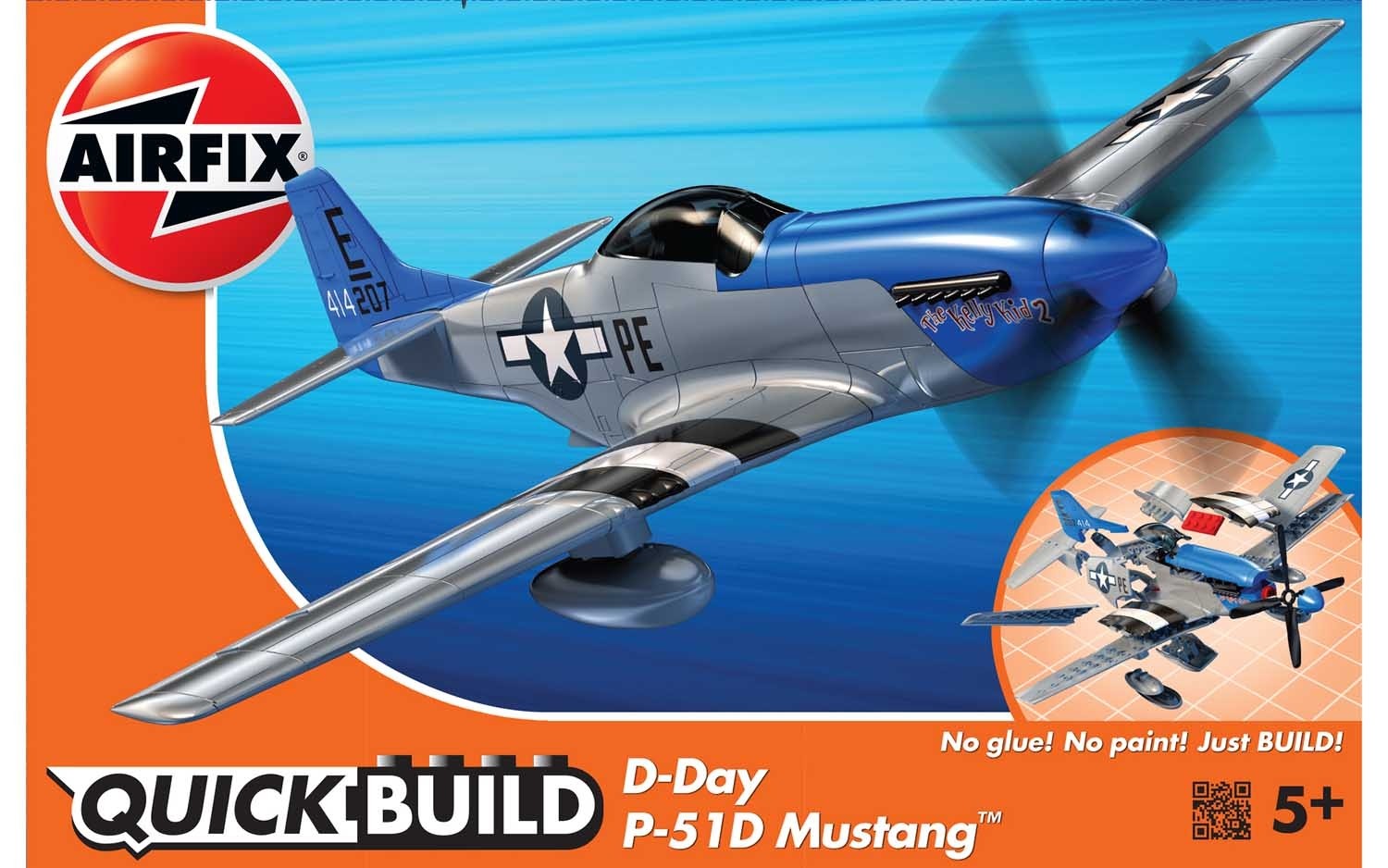« Go back« Go backPrevious Product (AXJ6033)Next Product (AXJ6045)
Airfix AXJ6046
- Description:
- North-American P-51 Mustang D-Day QUICK BUILD (No glue or paint required)
- Manufacturer:
- Airfix
- Code Number:
- AXJ6046
- Scale:
- Unknown
- Item type:
- Aircraft kits (injection)
- Price:
£14.99£13.49 (Put this on Backorder and save 10%!)- Order Quantity:
- Quantity In Stock:
 0
0
- Availability:
- This has sold out but will be back in stock again soon
- Wish List:
- Department:
- Catalogue
Here are some books and decals you might find useful for this kit
Found 6 related products
 | MA Publications - MAE04 - No Scale | Model Aircraft Extra 4. Building the North-American P-51D Mustang. WAS é£14.99. TEMPORARILY SAVE 1/3RD!!! Marrying an American dive-bomber design and a British engine, the North-American P-51 Mustang became one of the greatest fighters of World War II. The iconic P-51 was a World War II single-seat fighter and fighter-bomber that also saw service in the Korean War and other conflicts. The Mustang was designed in 1940 by North-American Aviation (NAA) in response to a requirement of the British Purchasing Commission. The Purchasing Commission approached North-American Aviation to build Curtiss P-40 fighters under license for the Royal Air Force (RAF). Rather than build an old design from another company, North-American Aviation proposed the design and production of a more modern fighter. The prototype NA-73X airframe was rolled out on 9 September 1940, 102 days after the contract was signed, and first flew on 26 October. The Mustang was designed to use the Allison V-1710 engine, which had limited high-altitude performance in its earlier variants. The aircraft was first flown operationally by the RAF as a tactical-reconnaissance aircraft and fighter-bomber (Mustang Mk I). Replacing the Allison with a Rolls-Royce Merlin resulted in the P-51B/P-51C (Mustang Mk III) model and transformed the aircraft's performance at altitudes above 15,000ft, without sacrificing range, allowing it to compete with the Luftwaffe's fighters. The definitive version, the P-51D, was powered by the Packard V-1650-7, a license-built version of the two-speed two-stage-supercharged Merlin 66 and was armed with six .50 calibre M2/AN Browning machine guns. From late 1943, P-51Bs and P-51Cs (supplemented by P-51Ds from mid-1944) were used by the USAAF's Eighth Air Force to escort bombers in raids over Germany, while the RAF's Second Tactical Air Force and the USAAF's Ninth Air Force used the Merlin-powered Mustangs as fighter-bombers, roles in which the Mustang helped ensure Allied air superiority in 1944. The P-51 was also used by Allied air forces in the North African, Mediterranean, Italian and Pacific theatres, and during World War II, Mustang pilots claimed to have destroyed some 4,950-enemy aircraft. At the start of the Korean War, the Mustang, by then redesignated F-51, was the main fighter of the United Nations until jet fighters, including North-American's F-86, took over this role, the Mustang then became a specialised fighter-bomber. Despite the advent of jet fighters, the Mustang remained in service with some air forces until the early 1980s. In Model Aircraft Extra #4, some 15 P-51 Mustang build projects will be included, in a 'how-to' format, and continue this fantastic series modelling guides from MA Publications, the new name in scale modelling. More | Aircraft books | Special Offers | £9.99 | |
MA Publications - MAE07 - No Scale | Building the Republic P-47D Thunderbolt. The Republic P-47 Thunderbolt Big, powerful, and truly a juggernaut of an aircraft, resulting in its appropriate nickname 'Jug', the Republic P-47 Thunderbolt was one of the really great warplanes of its generation. Alongside the superlative North-American P-51 Mustang and the twin-engined Lockheed P-38 Lightning, it was one of the three principal fighter types which the US Army Air Forces (USAAF) successfully operated in the later stages of World War Two. The initial production version was the P-47B, and examples of this type started to reach the USAAF's 56th Fighter Group in June 1942. The first really combat-ready model was the refined and slightly longer P-47C, which entered service later in 1942. Like all front-line P-47 versions it packed a formidable punch of four 0.5in M2 Browning machine guns in each wing, although early models did not carry the wing pylons that became so important later in the Thunderbolt's combat career. The first P-47C examples to reach Britain for the US Eighth Army Air Force did so in December 1942, followed by what became the main combat model of the Thunderbolt, the P-47D, in April 1943. Weighing in at some 15,000lb (6,804kg) fully loaded and powered by the R-2800-59 Double Wasp of 2,000hp, the P-47D was a big, powerful beast. Water injection introduced for some versions of the R-2800 would see even greater power on demand when needed in aerial combat. All of these early Thunderbolts had the 'razorback' high line rear fuselage pioneered with the P-35 and P-43, with a rearwards-sliding heavily framed cockpit canopy. Although the USAAF at first saw the Thunderbolt as a high altitude interceptor, its main initial role very soon became that of daylight bomber escort with the England- based Eighth Air Force, which was in great need of escort fighters for its B-17 Flying Fortresses and B-24 Liberators that were increasingly facing stiff Luftwaffe fighter opposition. he Thunderbolt helped to turn the tide for the US daylight bombing offensive during 1943 and early 1944, with a number of P-47 pilots gaining impressive scores in air-to-air combat against Luftwaffe fighters. Eventually the appearance of the Merlin-engined P-51B Mustang and later versions of the superb Mustang long-range fighter resulted in the Eighth Air Force almost completely re-equipping its fighter groups with the P-51, but the Eighth's 56th Fighter Group continued to fly the Thunderbolt right up to the end of the war in Europe in May 1945. The Eighth Air Force also pioneered the P-47 for air-to-ground operations as a part of its policy of taking the fight to the Luftwaffe, and additional to this the Thunderbolt eventually equipped several fighter groups specifically for fighter-bomber operations within the tactical England-based US Ninth Air Force. The P-47 proved to be a formidable fighter-bomber due to its impressive eight-gun armament, bomb load and ability to survive enemy fire. The underwing pylons that proved so useful for long-range fuel tanks were equally at home carrying a 500lb (227kg) bomb (one under each wing), and the Ninth Air Force in particular used this capability to devastating effect against German tactical targets before and after D-Day. 'Razorback' Thunderbolts additionally equipped USAAF units in Italy, the Pacific (including exceptional use by the Fifth Air Force), and the China-Burma-India theatre (CBI). Continuing development of the P-47 design led to the adoption later in P-47D manufacture of a cut- down rear fuselage spine and all-round vision 'bubbletop' canopy. This resulted in a further series of later Thunderbolt versions with even greater range and capabilities, but many 'razorback' P-47s nevertheless continued in service right to the war's end " some pilots in fact preferring the 'razorback' to the later models particularly for their better directional stability. Other important users of the Thunderbolt in World War Two included the Soviet Union, the RAF and the Free French. This seventh book in the highly successful MA Extra Series contains fourteen showcase and step by step model builds and will be a must for any P-47 aficionado! More | Aircraft books | Catalogue | £14.99 | ||
 | Mushroom Model Publications - MMP6143 - No Scale | North-American P-51B/P-51C & F-6C Mustang (Yellow Series) - Robert Pƒ"a"¢czkowski More | Aircraft books | Catalogue | £25.00 | |
 | Polish Wings - PWB80-7 - No Scale | Polish Wings No. 23. 303 Squadron North-American Mustang. No. 303 Squadron was the only Polish unit equipped with the Mustang IV, as the bubble-top P-51D and P-51K were known collectively to the RAF. Between April 1945 and December 1946, the squadron used a total of 29 of these aircraft, plus six Mustang I's as hacks. The book includes over 120 photos and nearly 30 colour plates to profusely illustrate these aircraft. Their technical details, military markings and maintenance stencils are shown in the detail. More | Aircraft books | Limited Availability | £15.00 | |
Valiant Wings Publishing - VWPAM-18 - No Scale | AM-18 - The North-American P-51D/K Mustang (inc. the P-51H & XP-51F, P-51G & P-51J) - A Complete Guide to the Cadillac of the Skies By Richard A. Franks The P-51 Mustang is one of the most popular aircraft modelling subjects around. Our latest book will go some way towards unpicking the different variants and colourful schemes that apply to the type. This eighteenth book in our much-acclaimed series. AM18 has now been expanded to 272 pages plus covers and plans section in order to accommodate extra material. Packed with vital information that no active modeller and USAAF enthusiast should be without. It will contain: 60+ pages of technical information 60+ pages of walk-around images and technical diagrams 8+ pages of camouflage and markings 25+ pages of model builds and modelling information 200+ photographs including wartime images Colour side views and four-views by Richard J. Caruana 3D isometric views of all variants by Wojciech Sankowski Specially commissioned extensive full kit builds by Libor Jekl & Steve A. Evans Specially commissioned front cover artwork by Jerry Boucher Bonus set of 1/48 scale plans More | Aircraft books (on modelling aircraft) | Catalogue | £24.95 | ||
Warpaint Series - WPSSP05 - None | Warpaint Special no 5 North-American P-51 Mustang - Warpaint Special no 5 aâé-¢ A massive 108 pages aâé-¢ Author superb and respected Kev Darling aâé-¢ Artwork by John Fox aâé-¢ Over 200 images some never seen before aâé-¢ 16 pages of Colour Profiles aâé-¢ 2 page scale Plans aâé-¢ 4 pages of detailed Aircraft used by various units More | Aircraft books | Catalogue | £22.00 |
Hannants Search Engine
| Search Area | Manufacturer | Item Type | Search | ||
|---|---|---|---|---|---|
| Part Number | Scale | Keywords | Results per Page | ||
| Exact Match | |||||
|
Sort by:
Sort Direction: | |||||
| Added Within | last week | last 2 weeks | last month | last 6 months | last year | |||||
|---|---|---|---|---|---|---|---|---|---|---|
Convert Currency
Copyright © 2001-2025 H. G. Hannant Limited. All rights reserved. | Website by Dessol
Privacy Policy | Cookie Information | Switch to Mobile Version












